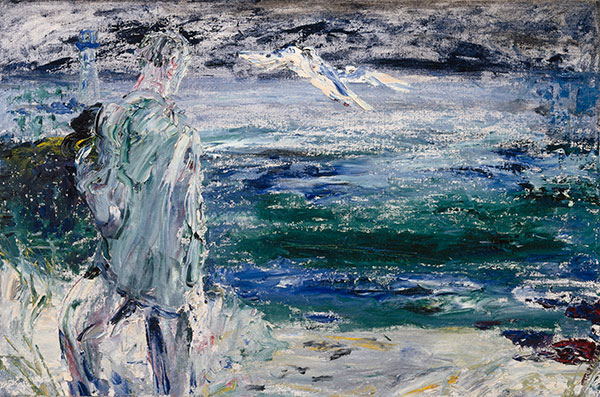National Gallery of Ireland until 6 February 2022
By Marie Bourke
This exhibition, which marks the 150th anniversary of the birth of this major Irish artist, focuses on Yeats’s memories, including those of his Sligo childhood that provided such a rich source of lifelong inspiration, and his oil paintings—about half of which he created in the final decade of his life.
Born in London, he was the youngest son of the painter John Butler Yeats (1839–1922) and Susan Pollexfen (1841–1900). His brother, the poet William Butler Yeats (1865–1939), was the eldest, and in between were his sisters Susan Mary (‘Lily’) (1866–1949), the embroideress, and Elizabeth Corbet (‘Lolly’) (1868–1940), the printer and publisher. When the sisters returned to Dublin, working first at Dun Emer Industries (1902–8) and then Cuala Industries (1908–45), Jack provided designs for church banners, bookplates, illustrations, and 84 issues of A Broadside. All four Yeats children were leaders in their various fields, having enormous influence on the cultural developments of twentieth-century Ireland.
Raised in Sligo over eight years by his Pollexfen grandparents, Yeats roamed freely, surrounded by hills, lakes and ocean, observing shopkeepers, priests and sailors, while attending sports, races, fairs and the circus. Lily noted that ‘he gathered much that has made him’. Although William and Jack both collected stories in Sligo, Jack absorbed the local way of life that would haunt his visual imagination. Aged seventeen, he rejoined his family in London, attended art schools and, between 1888 and 1891, began working as a commercial artist. He provided illustrations for 40 journals, books and broadsheets, several for his family. Yeats lived through the Easter Rising in 1916 (when four of his paintings were destroyed in the RHA), the establishment of the state and two world wars, while documenting life, including political events and the poverty in the west of Ireland. In 1924 he was the first Irish person to be awarded a silver Olympic medal, at the Paris games, for The Liffey Swim (1923).
In 1894 he married fellow artist Mary Cottenham White (Cottie), moving to Surrey, followed by Devon, and visiting Ireland each summer. In 1910 the Yeatses moved to Greystones, Co. Wicklow, then Donnybrook, before settling in 1929 at Fitzwilliam Square, Dublin. No matter where he went, including Italy, France, the Rhine and New York, Yeats’s thoughts returned to Sligo and the West. His early works were shown at exhibitions in London and Dublin entitled Sketches of Life in the West of Ireland. Between 1905 and 1907 he toured the West with J.M. Synge, illustrating Synge’s articles for the Manchester Guardian and two of Synge’s books. Watercolours like Memory Harbour (1900) depict the Sligo described by W.B. Yeats in ‘Reveries over Childhood and Youth’ (1916)—‘houses and anchored ship and distant light-house all set close together as in some old map’. When Jack published Life in the West of Ireland (1912), William recognised that ‘It is long since he lived there, but his memory seems as accurate as the sight of the eye’. Jack’s literary output included plays, prose, novels, A Broad Sheet (1902–3), A Broadside (1908–15) and, in 1930, his autobiographical memoir, called Sligo because ‘it ought to be a lucky name’.
Using sketch-books to record life, Yeats illustrated in ink and watercolour from 1897, using an early descriptive narrative style with a distinctive outline. Having moved to oils in 1909, he progressed to a more reflective manner, developing memory as a theme as his work loosened and became more fluid in the 1920s. And So My Brother Hail and Farewell for Ever More (1945) is a late work depicting a man carrying a knapsack standing on a Sligo headland with Blackrock Lighthouse in the background. He faces the deep blue-green Atlantic Ocean while musing on life and death as a seagull sweeps by, symbolising the flight of loved ones to eternity. It is executed in unmixed primary colours using a palette knife and expressive brushwork that conveys Yeats’s deepest feelings. Yeats recreated these remembered or imagined events, on mainly Irish themes associated with universal life, as paintings to enable strong emotions to be evoked about the original idea. Described by his sister Lily as inspiring affection and friendship, he was also private: ‘He was reticent, never talks of himself or his things’. He wanted viewers to interpret the pictures for themselves and to find their own meanings in his work.

Yeats was in his 70s when fame, recognition and honours came his way. He confronted tragedy in his final decade, including the loss of his family—William in 1939, Lolly in 1940, Cottie in 1947 and Lily in 1949—by dipping into his well of memories to produce a body of joyous, expressive, moving work, remaining an elusive figure to the end. From 1955 Yeats lived at Portobello Nursing Home, where he died, aged 85, in 1957. His unsold paintings were left to his niece, Anne Yeats. A leading figure in Irish art, he gained an international reputation with retrospective exhibitions in Britain and the United States. He is buried at Mount Jerome Cemetery, Dublin. ‘Jack, we have the good thought of you still.’
Marie Bourke is a cultural historian, formerly of the National Gallery of Ireland.
